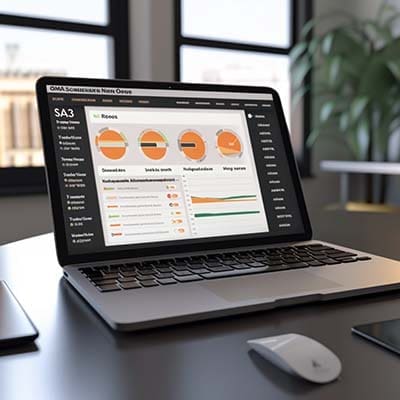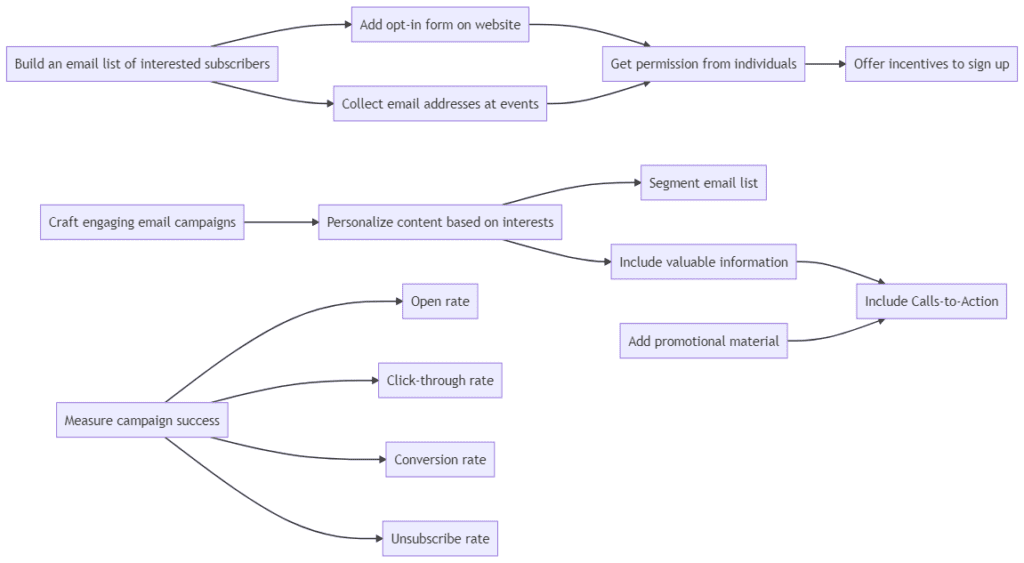Local Digital Marketing Strategies Every Small Business Needs to Know
The Power of Digital Marketing for Local Businesses
In today’s digital age, having a strong online presence is paramount to the success of any local business. In fact, online marketing has become an essential tool for local businesses looking to attract new customers, build brand awareness and increase revenue.

Effective digital marketing gives your small business power like never before!
Unlike traditional advertising methods such as print and radio ads which have limited reach and higher costs, digital marketing enables businesses to establish two-way communication with their target audience in real-time. The value of using local digital marketing strategies for small businesses cannot be overstated.
With the majority of consumers now using the internet to find products and services before making a purchase decision, it is crucial for local businesses to have an effective web presence in order to remain competitive. In addition to being cost-effective, marketing on the web provides local businesses with the ability to reach a wider audience beyond their geographic location by leveraging the power of search engines and social media platforms.
Overview of Steps to Building a Successful Online Marketing Strategy
Developing a comprehensive local business online marketing strategy can seem like an overwhelming task for most small business owners. However, by breaking down the process into manageable steps and focusing on key areas that are most relevant to your business goals, you can create an effective web marketing plan that delivers results. Here are some fundamental steps to building a successful digital marketing strategy:
- 1. Define Your Target Audience: Identify your ideal customer by creating detailed buyer personas that outline their preferences, pain points, and buying behaviors.
- Establish Your Online Presence: Build an optimized website that reflects your brand values and effectively communicates your products or services.
- Content Creation: Develop informative content that communicates your value proposition while incorporating SEO best practices into each piece.
- Paid Advertising: Choose advertising platforms relevant to your target audience, such as Google Ads or Facebook Ads; set up ad campaigns aligned with your business goals.
- Reputation Management: Monitor and respond to customer feedback on online review sites such as Yelp, Google Reviews, etc.; encourage positive reviews from satisfied customers.
- Email Marketing: Build an email list of interested subscribers; create engaging email campaigns that drive conversions; measure the campaign’s success.
- Analyzing Performance Metrics: Track key performance indicators such as website traffic, conversion rates, and ROI to measure the effectiveness of your Internet marketing endeavors. By following these steps, you can build a comprehensive Internet marketing plan that helps your local business stand out in a crowded marketplace and drive growth for years to come.
Define Your Target Audience
In order to effectively market your local business online, it’s crucial that you have a clear understanding of who your target audience is. This means identifying the individuals who are most likely to be interested in what your business has to offer. By knowing this demographic, you can tailor your messaging and marketing actions specifically to their needs and preferences.
Identifying Your Ideal Customer

Internet marketing is an essential way to connect with your ideal customers.
To begin defining your target audience, start by thinking about the type of person who would benefit the most from your products or services. Consider their age, gender, income level, education level, and other demographic factors that may be relevant.
You may also want to think about their lifestyle habits, hobbies or interests, and purchasing behaviors. Once you have a general idea of who your ideal customer is, it’s important to conduct further research to gain a deeper understanding of their needs and preferences.
Understanding Their Needs and Preferences
In order to successfully market your business online, you need to understand what motivates your target audience. What problems or pain points do they experience?
What goals do they have for themselves? What solutions are they looking for?
You can gather this information through online surveys or focus groups with existing customers or potential customers. You can also use social media listening tools or keyword research tools to identify common themes related to topics relevant to your business.
Creating Buyer Personas
A buyer persona is a fictional representation of your ideal customer based on the research you’ve conducted. It includes details such as demographics, behaviors, motivations and goals. Creating buyer personas can help you better tailor your messaging and marketing actions specifically toward these individuals.
To create a buyer persona for your local business digital marketing strategy:
- List out the characteristics of your ideal customer.
- Identify their common pain points or challenges.
- Outline their goals, both short-term and long-term.
- Consider what type of content or messaging would resonate with them best
Incorporating these insights into your Internet marketing strategy can help you create more targeted campaigns that are more likely to resonate with your target audience. By understanding the needs and preferences of your ideal customer, you can tailor your messaging and marketing efforts to speak directly to them and drive conversions for your business.
Establish Your Internet Presence

Optimizing for local should be the goal of small businesses and startups.
Building a Website that’s User-Friendly and Optimized for Search Engines
In today’s digital age, having a website is crucial for any local business. Your website should be user-friendly, easy to navigate, and visually appealing.
It should also be optimized for search engines so that potential customers can find you when they search online. Start by choosing a domain name that’s easy to remember and represents your business well.
Next, choose a website builder or platform that fits your needs and budget. Examples include WordPress, Wix, Squarespace, etc.
When building your website, make sure it’s mobile-friendly, as most people access the internet through their phones these days. Keep your design simple yet attractive with clean layouts and clear calls-to-action (CTAs).
Use high-quality images of your products or services to give visitors a better idea of what you offer. And don’t forget to optimize each page with relevant keywords so that it ranks higher in search engine results pages (SERPs).
Claiming and Optimizing Your Google My Business Listing
Google My Business is a free tool provided by Google that helps local businesses manage their web presence on Google Search and Maps. Claiming your listing ensures accurate information about your business is displayed when someone searches for you on Google Maps or Google Search.
Ensure the information you provide is up-to-date, i.e., phone number(s), address(es), hours of operation, etc. To optimize your listing, add high-quality photos showcasing the interior & exterior of premises as well as staff interaction with customers; add detailed descriptions about products/services offered; including reviews from satisfied customers; respond to inquiries within 24 hours; activate messaging if necessary; enable bookings through the platform or integrate with other booking systems such as OpenTable, etc.
Creating Social Media Profiles on Platforms Where Your Target Audience Is Active
Social media can be a powerful tool for local businesses to reach potential customers. It’s important to identify which platforms your target audience is active on and create profiles on those platforms. For example, if you’re targeting millennials, Instagram would be a good choice, whereas LinkedIn would be better suited for B2B businesses.
When creating your profiles, ensure they’re consistent with your brand image and messaging. Use high-quality images and videos to showcase your products or services.
Engage with your audience by responding to comments and messages in a timely manner. Join relevant groups or communities on these platforms that are related to your industry or niche.
You can also use social media advertising to reach a wider audience and drive traffic to your website or physical location. Establishing a web presence takes time, but it’s worth the effort as it helps in enhancing brand awareness, getting discovered by new customers, and driving sales growth.
Content Creation
Developing a Content Strategy That Aligns With Your Business Goals

Content marketing is an effective way to help customers find your business.
When it comes to content creation, it’s essential to have a strategy in place that aligns with your business goals. This means taking some time to figure out what you want to achieve with your content and how you plan on measuring success.
Are you looking to increase brand awareness? Drive more traffic to your website?
Generate leads or sales? Once you’ve identified your goals, you can then start developing a content plan that will help you achieve them.
When creating your content strategy, it’s important to consider factors such as your target audience, the type of content they’re interested in consuming, and where they’re most likely to find it. You should also take into account the topics that are most relevant and valuable to them.
This could include things like how-to guides or tutorials related to your industry, informative blog posts, or even engaging social media content. Whatever types of content you choose, make sure they align with your business goals and resonate with your target audience.
Creating Valuable, Informative Content That Resonates With Your Target Audience
Once you’ve developed a solid content strategy that aligns with both your business goals and the needs of your target audience, it’s time to start creating actual content. One of the keys here is ensuring that all of the content you create is valuable and informative for readers/viewers/listeners/etc., regardless of the format it takes (written articles/podcasts/videos/other).
Providing value through informative pieces will keep consumers returning for more. As part of this process, focus on developing high-quality pieces by conducting thorough research on each topic before creating any new piece.
Make sure all information is accurate from reputable sources – fact-checking is critical before publishing anything publicly! You should also ensure that any written copy follows a logical structure with proper formatting, including headings and subheadings where necessary to break up long pieces of content.
Incorporating SEO Best Practices Into Your Content
When creating any type of online content, it’s crucial to incorporate SEO best practices into your strategy. This ensures that your content is optimized for search engines so that it can be easily found by people searching for relevant topics through organic search results.
Some of the key things to focus on include using targeted keywords throughout your copy in an organic way (avoid keyword stuffing!), incorporating meta descriptions and tags where relevant, and making sure all images or other media used within your content are properly labeled with alt tags. By focusing on developing high-quality, informative content aligned with the needs of both your target audience and business goals while also incorporating effective SEO strategies, you can create a strong foundation for success in web marketing for your local business!
Paid Advertising
One of the most effective ways to reach your target audience and drive conversions is through paid advertising. There are a variety of advertising platforms available, but not all of them will be suitable for your business. It’s important to choose the right platforms that align with your business goals and cater to your target audience.
Choosing the Right Advertising Platforms for Your Small Business
Before you start setting up ad campaigns, you need to decide which advertising platforms will best serve your business needs. The most popular options include Google Ads, Facebook Ads, Instagram Ads, and LinkedIn Ads.
Each platform has its own unique strengths and weaknesses. For example, Google Ads can help you reach people who are actively searching for products or services like yours, while Facebook Ads can help you target people based on their interests, behaviors, and demographics.
To determine which platform is best for your business, consider factors such as your budget, target audience demographics, the nature of your product/service offerings, and what type of ads will work better on various platforms (e.g., text-based ads versus visual ads). It’s also essential to research competitor activity on these ad platforms so that you can gain insights into their strategy.
Setting up and Managing Effective Ad Campaigns
Once you’ve identified the right advertising platform(s) for your business needs, it’s important to set up effective ad campaigns that resonate with potential customers. This process involves creating compelling ad copy and visuals that grab attention while also being informative about what sets your product or service apart from competitors.
You’ll also need to identify appropriate keywords (for search-based advertising) or targeting options (for social media ads) based on user behavior data available via analytics tools. You should ensure that you’re managing campaign performance regularly by monitoring metrics like click-through rates, conversion rates, and overall ROI.
This will help you make informed decisions about which ad campaigns to continue running and which ones to pause. Adjusting your ad campaign strategy based on performance data will help improve the results of your advertising efforts over time.
Reputation Management

One of the key strategies that can help many small businesses is reputation management.
As a local business owner, your online reputation is crucial to your success. In today’s digital age, people turn to the internet to research products and services before making a purchase.
This means that your online reviews and feedback from customers can make or break your business. It’s important to actively monitor your online reviews on platforms like Google, Yelp, and Facebook.
Positive reviews provide social proof that can attract new customers, while negative reviews can damage your reputation and drive potential customers away. Responding to negative reviews in a professional manner demonstrates that you care about customer satisfaction and are willing to address any issues they may have had.
Monitoring Online Reviews
The first step in managing your online reputation is monitoring what people are saying about your business online. Set up alerts on review sites so you’ll be notified when someone leaves a new review. Check your social media accounts regularly for comments and messages from customers.
When monitoring reviews, pay attention to recurring themes in negative feedback – it may indicate an area of improvement for your business. Additionally, keep an eye out for fake or spammy reviews – if you suspect a review isn’t legitimate, report it to the platform it was posted on.
Responding to Negative Reviews
No one likes receiving negative feedback about their business, but how you respond can make all the difference. It’s essential to respond promptly and professionally to negative reviews – ignoring them won’t make them go away.
In responding to negative feedback, focus on acknowledging the customer’s experience and apologizing for any issues they faced. Avoid being defensive or confrontational – this will only escalate the situation further.
Encouraging Positive Reviews
The best way to counteract negative reviews is by encouraging satisfied customers to leave positive feedback. Make it easy for customers to leave reviews by including links to your business profiles on review sites in your email signature, on your website, and in the follow-up communication after a purchase. Consider incentivizing reviews with a discount or special offer – just be sure to disclose any incentives you’re offering in compliance with review platforms’ guidelines.
Remember, building a positive online reputation takes time and effort – but the benefits of a strong reputation can’t be overstated. By actively monitoring and managing your Internet presence, you can build trust with potential customers and drive growth for your local business.
Email Marketing
Building an email list of interested subscribers
Email marketing is a great way to connect with your audience and keep them engaged with your business. To get started, you’ll need to build an email list of interested subscribers.
One way to do this is by adding an opt-in form on your website where visitors can sign up to receive updates and special offers from your business. You can also collect email addresses at trade shows, events, or in-store.
It’s important to make sure that you’re getting permission from individuals before adding them to your email list, as sending unsolicited emails can lead to spam complaints and damage the reputation of your business. To incentivize people to sign up for your newsletter, consider offering a free resource such as an e-book or discount code.
Crafting engaging email campaigns that drive conversions
Once you have built an email list, it’s time to craft engaging campaigns that drive conversions. The key here is personalization – addressing subscribers by name and tailoring the content based on their interests and behaviors. This can be done through segmentation of the email list based on factors like past purchase history or website behavior.
In terms of content, it’s important to strike a balance between promotional material and valuable information that subscribers will find useful. Including calls-to-action (CTAs) throughout the email, campaign can help drive conversions by encouraging recipients to take specific actions, such as making a purchase or registering for an event.
Measuring the success of email campaigns
It’s important to measure the success of your email campaigns in order to optimize future efforts. Metrics such as open rate (the percentage of recipients who opened the email), click-through rate (the percentage who clicked on links within the email), conversion rate (the percentage who completed a desired action), and unsubscribe rate are all indicators of how well your email campaign performed. Using this data, you can make adjustments to the content, timing, or targeting of future campaigns in order to improve results.
It’s important to keep in mind that email marketing is an ongoing process of testing and refining, so don’t be discouraged if your first few campaigns don’t yield the desired results. With time and effort, you can build a successful email marketing strategy that drives conversions and strengthens relationships with your audience.
Analyzing Performance Metrics

To get the most from your time and resources, track your marketing initiatives.
Tracking the performance of your digital marketing system is essential to ensuring that it’s effective in driving traffic and conversions. There are a variety of key performance metrics, or KPIs that you should be tracking on a regular basis to measure the success of your strategy. These include website traffic, bounce rates, conversion rates, email open and click-through rates, social media engagement metrics, and more.
Google Analytics is an incredibly powerful tool for tracking website performance metrics. With it, you can track how many visitors your site receives, where they’re coming from geographically and demographically, how long they stay on your site, and which pages they visit most frequently or spend the most time on.
This information can help you identify areas for improvement in terms of content or user experience. Additionally, tracking social media engagement metrics such as likes and shares can help you understand which platforms are most effective for reaching your target audience.
Conclusion
Building a successful Internet marketing plan takes time and effort but pays off in the end by helping local businesses connect with potential customers and grow their business. By identifying your target audience, and establishing an online presence through website creation and social media profiles while incorporating SEO best practices into content creation. Additionally, utilizing paid advertising options like Google ads to reach those audiences; monitoring online reviews; crafting engaging email campaigns that drive conversions; tracking KPIs through google analytics to better understand customer behavior online- all these strategies will help you build a solid foundation for your business’s online marketing efforts.
By regularly analyzing performance metrics tied to these strategies, we can adjust our approaches as necessary, ensuring continued growth over time! With these tips will be well on our way toward building a successful digital marketing campaign that will pay dividends long into the future!


